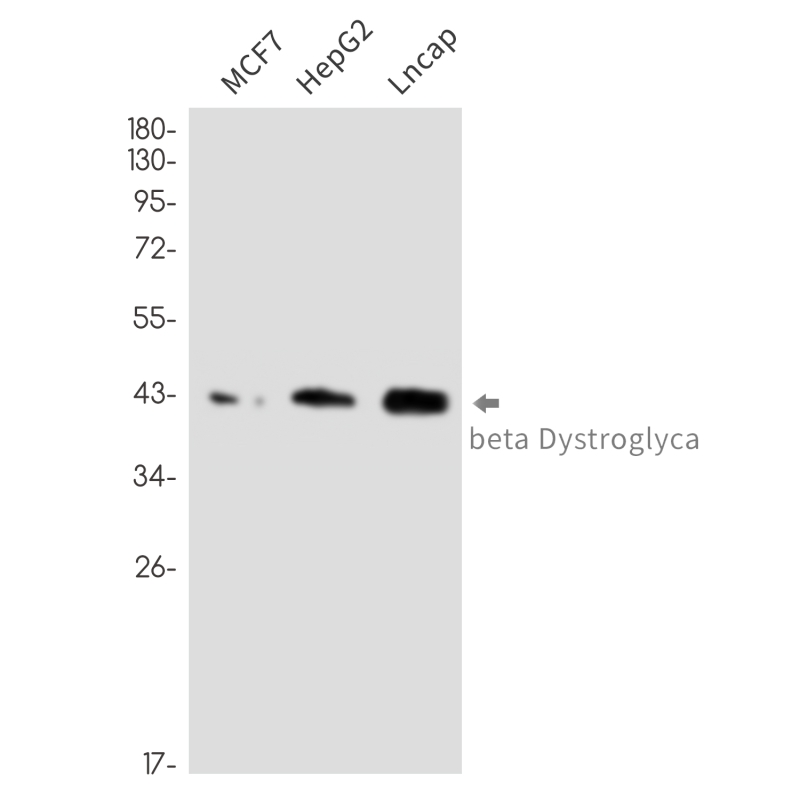
| WB | 1/500-1/1000 | Human,Mouse,Rat |
| IF | 咨询技术 | Human,Mouse,Rat |
| IHC | 咨询技术 | Human,Mouse,Rat |
| ICC | 技术咨询 | Human,Mouse,Rat |
| FCM | 咨询技术 | Human,Mouse,Rat |
| Elisa | 咨询技术 | Human,Mouse,Rat |
| Aliases | A3a; DAG; AGRNR; 156DAG; MDDGA9; MDDGC7; MDDGC9; LGMDR16 |
| Entrez GeneID | 1605 |
| WB Predicted band size | Calculated MW: 97 kDa; Observed MW: 42-44 kDa |
| Host/Isotype | Rabbit IgG |
| Antibody Type | Primary antibody |
| Storage | Store at 4°C short term. Aliquot and store at -20°C long term. Avoid freeze/thaw cycles. |
| Species Reactivity | Human |
| Immunogen | A synthetic peptide of human beta Dystroglycan |
| Formulation | Purified antibody in TBS with 0.05% sodium azide,0.05%BSA and 50% glycerol. |
+ +
以下是关于β-Dystroglycan抗体的3篇参考文献,按您的要求整理:
---
1. **文献名称**: *Primary structure of dystrophin-associated glycoproteins linking dystrophin to the extracellular matrix*
**作者**: Ibraghimov-Beskrovnaya O, et al.
**摘要**: 该研究首次克隆并鉴定了β-Dystroglycan的结构,证明其作为跨膜蛋白连接细胞外基质与肌动蛋白细胞骨架。文中使用特异性抗体验证了β-Dystroglycan在肌肉组织中的定位,并揭示其在维持肌细胞膜稳定性中的关键作用。
---
2. **文献名称**: *Post-translational disruption of dystroglycan–ligand interactions in congenital muscular dystrophies*
**作者**: Michele DE, et al.
**摘要**: 本研究通过β-Dystroglycan抗体分析发现,先天性肌营养不良症患者的Dystroglycan糖基化异常,导致其与细胞外基质蛋白(如层粘连蛋白)结合能力丧失,揭示了糖基化修饰对疾病病理的直接影响。
---
3. **文献名称**: *Dystroglycan in the diagnosis of muscular dystrophy: Immunohistochemical and immunoblotting approaches*
**作者**: Saito Y, et al.
**摘要**: 研究系统评估了多种β-Dystroglycan抗体在肌肉活检中的诊断应用,通过免疫组化和Western blot比较不同肌营养不良亚型中β-Dystroglycan的表达差异,证实其作为生物标志物的可靠性。
---
**备注**:若需更多文献或具体年份/期刊信息,可进一步补充数据库检索结果。
**Background of Beta-Dystroglycan Antibodies**
Beta-dystroglycan (β-DG) is a transmembrane glycoprotein encoded by the *DAG1* gene, forming a critical component of the dystrophin-glycoprotein complex (DGC). This complex stabilizes cell membranes by linking the extracellular matrix (via alpha-dystroglycan) to the intracellular cytoskeleton. β-DG plays essential roles in maintaining structural integrity, signal transduction, and mechanical stability in muscle, nerve, and epithelial tissues.
Antibodies targeting β-DG are vital tools for studying its expression, localization, and post-translational modifications, particularly glycosylation defects linked to muscular dystrophies (e.g., congenital muscular dystrophy) and cancers. These antibodies are used in techniques like Western blotting, immunohistochemistry, and immunofluorescence to assess protein levels, tissue distribution, and interactions with partners like dystrophin or laminin.
Research using β-DG antibodies has revealed its involvement in pathogenesis; reduced or aberrantly glycosylated β-DG disrupts cell-matrix interactions, contributing to muscle degeneration or metastatic spread in cancers. Additionally, these antibodies help evaluate therapeutic interventions aiming to restore DGC function. Commercial β-DG antibodies are often validated for specificity across species, but variability in glycosylation states may affect detection, requiring careful experimental optimization. Overall, β-DG antibodies remain indispensable for exploring DGC biology and related diseases.
×